By Debbie Piesen
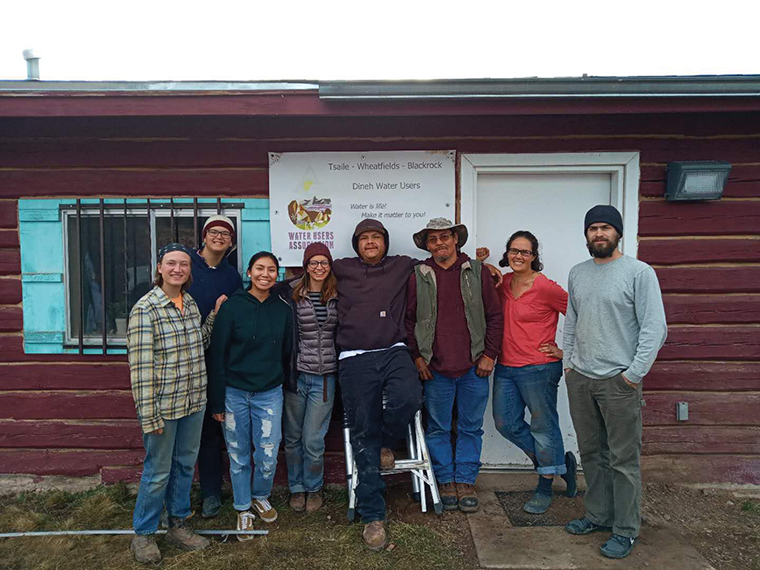
On I-40 West in New Mexico, 200 miles from our destination, Cheryl blew a tire. Cheryl is our trailer, and she was heavily loaded down with the solar equipment that we planned to install in Tsaile, Arizona, in the Navajo Nation. When we pulled over we noticed that Bert, our ’97 Ford Explorer, was smoking like a chimney. Cheryl and Bert had decided they had enough, leaving us stuck somewhere in the New Mexico desert, almost 2000 miles from our home at Living Energy Farm in Louisa, Virginia.
I’ve lived at Living Energy Farm (LEF), an off-grid intentional community, for about 10 years. In this time we have developed a uniquely simple, inexpensive, and reliable off-grid solar energy system that we call a DC Microgrid. This system is what brought Bert, Cheryl, and our four women crew—Onyx, Stephanie, Jessie, and me—to break down under the New Mexico sky. In 10 years, our lights at LEF have never gone out. We have been able to live so well off the grid that we thought we should try our best to promote this system far and wide as a viable alternative to grid power from coal, nuclear, and frack gas.
Convincing Americans to go off-grid, however, is no easy task. There’s a lot of stereotypes and assumptions about off-grid living, even among progressive people and people living in intentional communities. The bad reputation of off-grid living is largely due to the bad design of conventional AC-based solar systems. Even though we have had some small successes in convincing our fellow communitarians to adopt our DC Microgrid, the going has been slow and frustrating. So we decided to turn our attention to rural communities living without grid power involuntarily, who we thought would be more receptive to our energy model.
Our research told us that the largest numbers of people without access to grid power in the US live in the Navajo and Hopi reservations. Many people do not have the money to connect to the grid, are denied grid power for political reasons, or choose not to use grid power because of their traditions or environmental values. We contacted several organizations in the Navajo and Hopi reservations, including Dineh Water Users, which promotes sustainable agriculture in the Tsaile/Wheatfields area. (Dineh is what the Navajo people call themselves.) They offered to host us and facilitate the nonprofit distribution of our solar lighting and charging kits to their community.
It was a noble vision. Broken down in New Mexico, our crew had the tools, the equipment, the skills, and the drive, but not the vehicle. We called up the office of Dineh Water Users, to let them know that we would be delayed due to car trouble. Much to our surprise and gratitude, they offered to send their farm truck and 30 ft. trailer, and haul us the remaining 200 miles up to Tsaile/Wheatfields.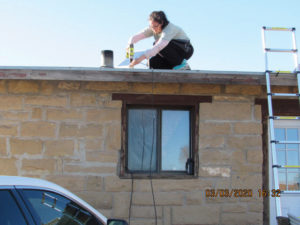
As our Dineh saviors, Emerson and Darron, ratcheted our rig onto their trailer, our crew helped out or yelled encouragement, “Goooo Bert!” Finally on the road to our destination, Emerson told us that Bert and Cheryl were loaded way over capacity, and asked us how long we had driven the rig.
“Four days, almost 2000 miles,” we told him.
“OK, another question, are you crazy?”
Emerson and Darron cheerfully delivered us to our destination at the Dineh Water Users office. They helped us get situated and offered to work on our vehicle. In the meantime, they said, we could use their farm truck to get to our installations.
Here on the reservation, the idea of driving 400 miles to help a friend you barely know, and working on their truck for free, is totally normal. So is living in community, living modestly, and living without grid power. The pace of life here and the way folks relate to each other has a lot in common with the network of communes we are part of in Louisa. Even the dirt roads, which connect many people’s houses to the main road, are reminiscent of our community back in Virginia. It’s funny to drive 2000 miles to feel very much at home.
We started installations the next day, bright and early. Since then, we have been learning a lot about the electrical situation out here. There’s a lot of abandoned equipment, dead batteries, and other failed attempts to go solar. The truth is that the solar industry has largely failed the poor rural people who need alternative energy systems the most. 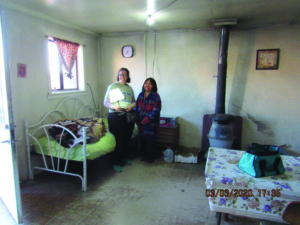
Conventional off-grid solar systems supply AC (alternating current) in order to run “normal” appliances. But solar panels produce DC (direct current). Inverters are needed to turn DC into AC. Inverters drastically reduce efficiency, and require a large battery bank. AC-based systems typically use lead acid batteries, which don’t last more than five years or so (lithium might last eight or 10 years, but is much more expensive). These systems require a steady stream of investment ($1,000-$2,000 per year is typical) to replace dead equipment. As the batteries age, they are less able to power heavy loads like refrigerators, meaning the system is likely to shut down during cloudy spells. Most people living off-grid rely on generators to keep their batteries topped off.
A DC Microgrid, the system we developed at Living Energy Farm, eliminates the need for an inverter, so battery banks can be smaller and still be effective. We use nickel iron batteries, which last 40 years or more, to power lights and electronics at night. To minimize demand on our batteries, we run high-wattage appliances as “daylight drive.” Daylight drive (sometimes called direct drive) appliances run directly off of photovoltaic panels when the sun is shining. We store daylight drive energy as hot or cold thermal mass or pressurized water, which is cheaper and more resilient than electrical storage. We run a refrigerator, washing machine, and shop tools; our house stays warm all winter; we can take a hot shower whenever we want. We don’t own a generator, because we don’t need one. Our system works so well because it prioritizes efficiency, conservation, and direct use of solar electricity. And it is not expensive. We estimate our electrical expenses at Living Energy Farm at about $50 per year.
So why does the AC model dominate off-grid solar design, when it is so expensive, and doesn’t even work well? One reason is that people are used to thinking about energy in terms of production, instead of thinking about conservation and timing of use. The AC model perpetuates the illusion of unlimited energy at any time, which is not actually possible with solar, but fits with the way people like to think about energy.
Another reason the AC model dominates is that it’s not profitable to sell durable equipment. Wealthy people want batteries that are lightweight and power dense, and don’t mind if they last only a few years. Corporations are very happy with this planned obsolescence model, which is obviously more profitable for them. So what if it leaves poor people in the dark, when they can’t afford to replace their batteries?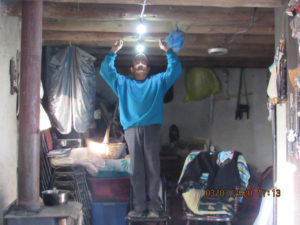
AC off-grid solar design has failed as a scalable solution for climate change. Another inconvenient truth is that the green dream of a solar-powered smart grid is probably never going to happen. Industrial solar and wind production is only cost-effective when an equal capacity of fossil fueled production exists for when the sun isn’t shining or the wind isn’t blowing. And sorry Bill McKibben, but industrial-scale lithium battery storage is a pipe dream of the wealthy: lithium is expensive, short-lived, reliant on scarce conflict materials, and no cost-effective recycling process exists.
The DC Microgrid model represents a powerful, simple, accessible solution for addressing climate change. People just need to use it.
Many others have pointed out the irony that the people who have done the least to create the climate crisis are suffering from it first and worst. There’s another irony, which is that those who have done the least to create the environmental crisis are probably going to be the first to embrace the tools that can get us out of it. Because living on solar energy is actually really easy, if you are willing to live modestly, share resources, and prioritize conservation. You might have to charge your laptop during the day to save your battery capacity for lighting at night. Maybe you’ll have to use an efficient chest refrigerator instead of an upright, and have oversized storage tanks for water, so you don’t have to run a pump at night.
For folks out here on the reservation, these “sacrifices” are not a big deal. People are so happy to get our systems and go solar. We’ve raised the funds to donate 50 lighting and charging systems, which we are installing in this month (March 2020). Dineh Water Users is interested in becoming a distributor for our lighting and charging kits, DC refrigerators, and the parts and accessories for these kits. It can be an income stream for their organization. While folks here are poor by mainstream standards, many of them have the resources to afford our systems (or upgrade the ones we are giving away). Our kits range in price from $300 to $1400, which is much more accessible than a $30,000 conventional off-grid kit, or the $12,000 that the local utility charges to hook up rural home sites to the grid.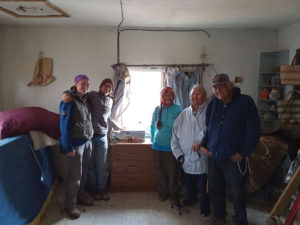
When my community first considered the idea of doing nonprofit installations on the Navajo and Hopi reservations, I admit that I was resistant to the idea, because I really didn’t want us to fall into the white savior mentality. But now that I’m out here, I’m so glad we’re doing it. Because the tools exist right now to live without coal, nuclear, and frack gas. The challenge of a sustainable future lies not in the technology itself, but in finding the willingness to use it, to live joyfully with the rhythms of the sun. This is one of the many lessons that the Navajo and Hopi people can teach us.
Like Bert and Cheryl, Euro-American culture is broken down on the side of the road, unable to move on to a solar-powered future. In the meantime, indigenous people will show us the way forward, if we are willing to listen.
Debbie Piesen is a cofounder of Living Energy Farm, an off-grid community of a dozen people in Louisa, Virginia. When she’s not installing solar electric systems, she manages her community’s organic seed farm. She has two kids, aged eight and five, who are both named after persimmons.
You can find out more about Living Energy Farm’s solar kits at www.livingenergylights.com.
